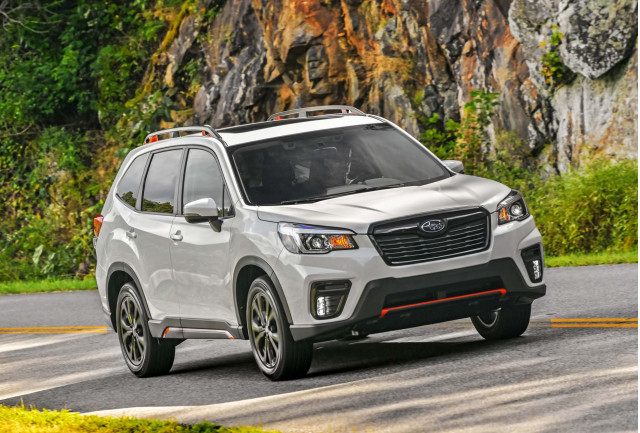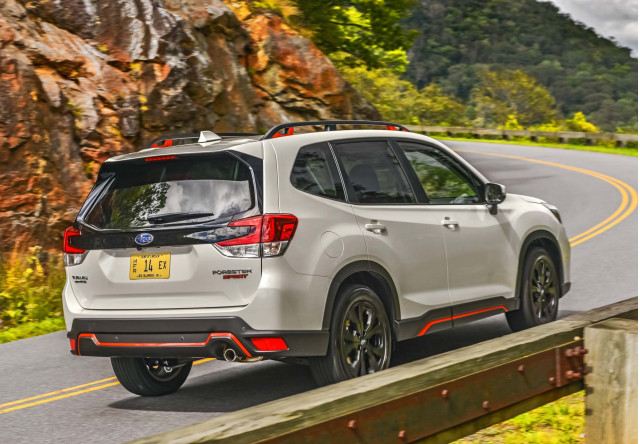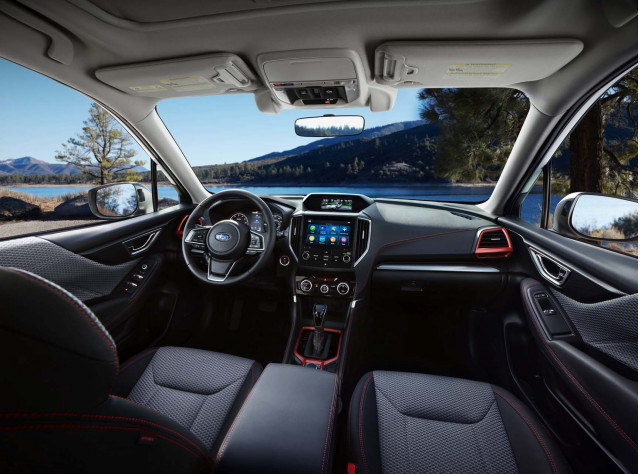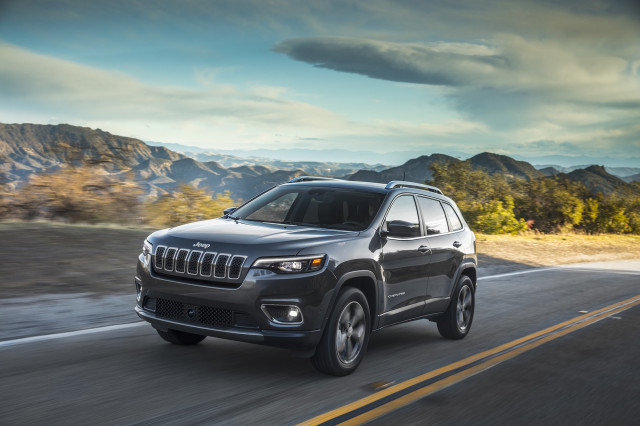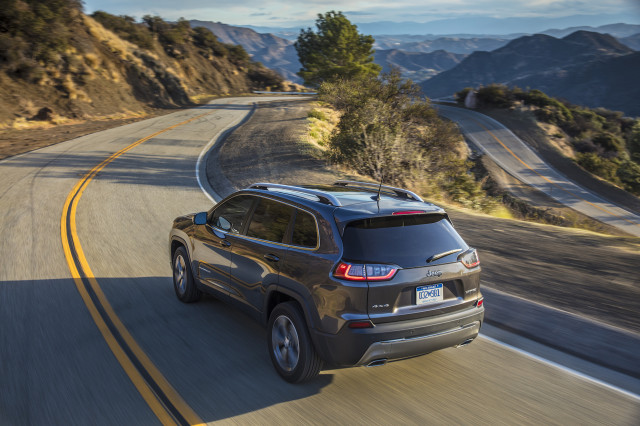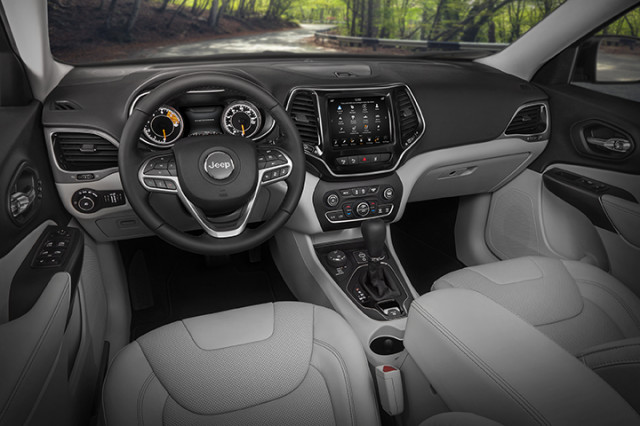Crossover SUV shoppers looking to tread beyond paved parking lots might whittle their car-shopping lists down to two models: the 2019 Jeep Cherokee and the 2019 Subaru Forester.
These right-size, five-seat crossover SUVs deliver on the promise of four-wheeling capability in flashy brochures and advertisements.
Spoiler alert: We like the 2019 Forester. A lot, it turns out. We rated it our Best Car To Buy 2019, which is why the Subaru scored 6.4 out of 10 points. At 5.8 points, the 2019 Cherokee isn’t too far behind.
The Cherokee’s score is helped by the breadth and depth of its lineup. It’s offered in more trim levels and powertrain combinations, with a far wider price range. Every Forester uses a 182-horsepower 2.5-liter flat-4 paired to a continuously variable transmission (CVT) that sends power to all four wheels. Fuel economy at 29 mpg combined is a stronger selling point than acceleration. The Forester moves adequately, but not hurriedly.
2019 Subaru Forester Sport
2019 Subaru Forester Sport
2019 Subaru Forester Sport
Base Cherokees use a 2.4-liter inline-4 rated at 180 hp, which seems like it would be a fair comparison to the Subaru’s engine. However, the Jeep’s engine is short on refinement and is paired to a 9-speed automatic transmission that can fumble its way through gears. The next step up is a 3.2-liter V-6 that makes 271 hp. New this year is a 2.0-liter turbo-4 that spins out 270 hp and is offered as a premium engine on all but the base Cherokee. We recommend either of the more powerful engines with the caveat that they’re much thirstier, with most models hovering between 22 and 24 mpg combined.
Jeep may have a deserved reputation for off-roading, but Cherokees in the Sunbelt are more likely to have front-wheel drive. Two available all-wheel-drive systems on the Jeep provide good traction in any situation. The Jeep Drive II system in the Cherokee Trailhawk features a simulated low range for more serious off-roading plus traction control modes for various road surfaces.
The Forester’s all-wheel-drive system is similarly transparent. A switch in front of the CVT lever engages an off-road traction control mode that Subaru says is equally useful in deeper snow.
All Forester trims—base, Premium, Sport, Limited, and Touring—have 8.7 inches of ground clearance. The Cherokee Trailhawk can clear similar obstacles thanks to its 8.7-inch rating and chunky all-terrain tires, but other trims sit much closer to the ground and have low-hanging bumpers that aid aerodynamics but can get caught on rocks.
The Cherokee Trailhawk is the off-road winner in this contest, but not by as much as many buyers might think.
Everyday utility
The Cherokee and Forester are sized about the same outside, but they tell different stories inside. Massive windows, low sills, and a high seating position give all passengers in the Forester a commanding view of the road. The Cherokee is more compromised with its higher sills and beefy roof pillars.
Front-seat riders will find power-adjustable driver’s seats in higher trims of both crossover SUVs. The Forester reserves power adjustability for the Touring trim level’s passenger seat, while Jeep makes that desirable feature standard on Limited and Overland trims and optional on the Trailhawk.
2019 Jeep Cherokee
2019 Jeep Cherokee
2019 Jeep Cherokee
Rear-seat riders will find exceptionally wide-opening doors and terrific ingress and egress in the Forester. Once aboard, the Forester has far more head and leg room than the Jeep, too. Cargo space is also a runaway victory for the Subaru. Not only is its tailgate much wider, liftover height is lower and it’ll hold about 7 cubic feet more luggage with the rear seats upright. Fold the rear seats flat and Forester’s space grows to 76 cubic feet, while the Jeep trails at just 55 cubes.
We also applaud Subaru for making most active safety features standard in the Forester. On the Jeep, buyers will have to pay extra for automatic emergency braking, adaptive cruise control, and active lane control—and those features aren’t available on the popular Latitude and Latitude Plus trim levels.
The Cherokee costs about $26,000 to start in Latitude trim with front-wheel drive. Add all-wheel drive and that price climbs to about $27,500. The base Forester includes all-wheel drive and is priced at about $25,300.
The Cherokee Trailhawk makes more sense for adventurous shoppers, however, with its added ground clearance, improved all-wheel-drive system, and all-terrain tires. It costs about $34,500 to start, which is about the same as the range-topping Subaru Forester Touring. Add a few options such as active safety tech and the Cherokee Trailhawk can easily top $40,000. However, Jeep tends to offer much larger incentives on the Cherokee than Subaru does on the Forester, which can considerably reduce that price gap.
Still, we’d put our money on a Forester—a Premium with a few niceties costs less than $30,000 and represents one of the best values on a new crossover SUV today.
Summary
Styling
Performance
Comfort & Quality
Safety
Features
Fuel Economy
MSRP
Invoice
Fuel Economy – Combined City and Highway
Engine
Drivetrain
Source: Read Full Article

